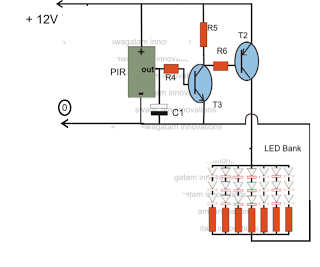
Ring-Around LED Flasher

This schematic diagram illustrates a ring-around LED flasher circuit. The circuit operates by turning off two LEDs while activating the other two, continuing this pattern until the timing cycle reverses.
The ring-around LED flasher circuit is designed to create a visually appealing light effect by alternating the illumination of two pairs of LEDs. The circuit typically consists of a microcontroller or a timer IC that generates a control signal to manage the timing of the LEDs.
In a standard configuration, two LEDs are connected in series with current-limiting resistors to ensure that they operate within their specified voltage and current ratings. The microcontroller or timer IC is programmed to activate the first pair of LEDs while simultaneously deactivating the second pair. After a predetermined interval, the states of the LEDs are reversed, resulting in a continuous flashing effect.
The timing cycle can be adjusted by changing the values of the timing components, such as resistors and capacitors, associated with the timer IC or microcontroller. This allows customization of the speed at which the LEDs alternate, providing flexibility for different applications.
Power supply considerations must also be addressed, ensuring that the circuit operates within the voltage range suitable for the selected LEDs and control components. Additionally, the use of a breadboard or PCB can facilitate prototyping and assembly, allowing for easy modifications and testing of the circuit design.
Overall, the ring-around LED flasher circuit is an effective way to create dynamic lighting displays, suitable for decorative purposes, signaling, or as part of larger electronic projects.This schematic diagram shows a ring-around LED flasher circuit. This circuit will turn off two LEDs and turn on the other two until the timing cycle reverses 🔗 External reference
The ring-around LED flasher circuit is designed to create a visually appealing light effect by alternating the illumination of two pairs of LEDs. The circuit typically consists of a microcontroller or a timer IC that generates a control signal to manage the timing of the LEDs.
In a standard configuration, two LEDs are connected in series with current-limiting resistors to ensure that they operate within their specified voltage and current ratings. The microcontroller or timer IC is programmed to activate the first pair of LEDs while simultaneously deactivating the second pair. After a predetermined interval, the states of the LEDs are reversed, resulting in a continuous flashing effect.
The timing cycle can be adjusted by changing the values of the timing components, such as resistors and capacitors, associated with the timer IC or microcontroller. This allows customization of the speed at which the LEDs alternate, providing flexibility for different applications.
Power supply considerations must also be addressed, ensuring that the circuit operates within the voltage range suitable for the selected LEDs and control components. Additionally, the use of a breadboard or PCB can facilitate prototyping and assembly, allowing for easy modifications and testing of the circuit design.
Overall, the ring-around LED flasher circuit is an effective way to create dynamic lighting displays, suitable for decorative purposes, signaling, or as part of larger electronic projects.This schematic diagram shows a ring-around LED flasher circuit. This circuit will turn off two LEDs and turn on the other two until the timing cycle reverses 🔗 External reference





